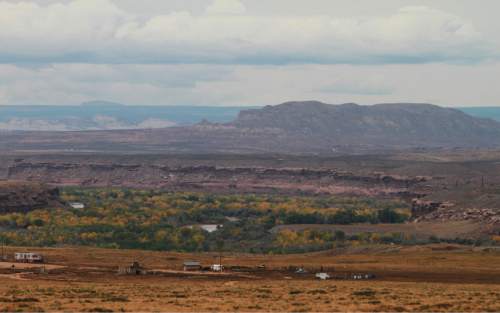This is an archived article that was published on sltrib.com in 2015, and information in the article may be outdated. It is provided only for personal research purposes and may not be reprinted.
A federal judge has ruled in a lawsuit brought by the Navajo Nation that San Juan County school board election districts are unconstitutional and says they must be redrawn.
U.S. District Judge Robert Shelby found that because the San Juan County districts from which school board members are elected are not largely equal in population, they violate the Equal Protection Clause of the U.S. Constitution that requires citizens to be equally represented — the concept of one person, one vote.
Shelby also pointed out that Utah law requires San Juan County to draw board districts so they are "substantially equal" in population. They also must be altered with population changes, a requirement that the judge said the county has ignored.
"To secure the right to vote, which is 'preservative of all rights,' new election districts must be established," Shelby wrote, citing an 1886 court decision.
The Navajo Nation and six members sued San Juan County in 2012, alleging that the county was attempting to keep Navajos from capturing a second seat on the county's three-member commission by failing to redraw voting districts to reflect the 2010 U.S. Census. It amended the lawsuit later that year to claim that school board districts also had unbalanced populations to the detriment of tribal members who live in the county.
Shelby's decision filed on Wednesday covers only the school board district. The lawsuit continues over the commission districts.
Attorneys for the Navajo Nation said they were preparing a news release in reaction to the decision. An attorney for San Juan County said he was not immediately available to comment.
The decision cites 2010 census figures that San Juan County, in Utah's far southeastern corner, had 14,476 citizens, including 3,000 schoolchildren who attended 12 schools. San Juan County elects a five-member school board, one member from each of five districts. The county commission established the districts in 1992 but has not redrawn them since.
District 1 in the northern part of the county has a population of 3,285, while District 5, which includes schools on the Navajo reservation, has a population of 2,195, a difference of about 38 percent from an ideal distribution in which the districts would all have an equal population.
The Navajo lawsuit claimed election districts in San Juan County were racially discriminatory and in violation of the U.S. Constitution and Voting Rights Act. The part of the lawsuit that Shelby ruled on said that the unequal population distribution of the school districts violated the one-person, one-vote provisions of the Equal Protection Clause of the Constitution.
San Juan County argued that there were legitimate reasons for the unequal districts, such as its small population, uneven geography and a lack of registered voters with a physical address, which made it difficult and expensive to draw up equal districts. It also said it was trying to ensure that each school had representation on the board and that the "under-representative" District 1 is majority white, while the "over-represented" District 5 is majority American Indian.
In a declaration to the court, Superintendent Douglas Wright said the election districts were established around the county's four high schools and their feeder schools in order to ensure strong community representation.
"As a member of the community, it is believed that the board member will have a strong interest in supporting the schools within his/her community," Wright said.
Shelby dismissed those arguments.
"San Juan County has failed to offer legitimate interests for denying the political representation afforded by one person, one vote, or to demonstrate that its interests are necessary to impair the rights of its voters," the judge wrote. "The county has not met its burden to justify its ongoing failure to comply with the Equal Protection Clause."
Jesse Trentadue, a Salt Lake City attorney who represented San Juan County, said the case presents a unique legal problem because of its huge size and small population.
Most cases on redistricting that have made it to the Supreme Court "typically deal with Eastern states or large population areas," he said. "This presents a novel question in terms of what the law is and what the law should be when you're dealing with the unique characteristics of San Juan County."



